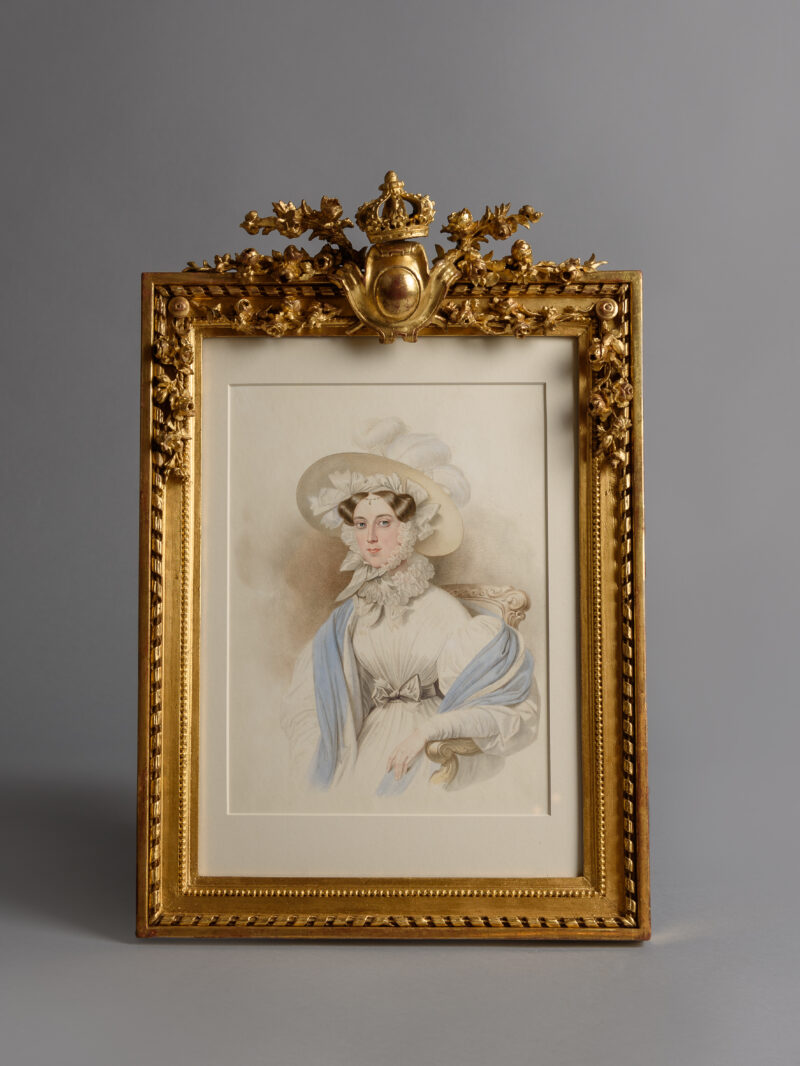
Portrait of the Empress of Austria, Maria Anna (1803 – 1884)
Executed by Josef Kriehuber (1800 – 1876) in the historic frame with an imperial crown.
The present watercolor and gouache painting is of the finest quality, created by one of the most important and successful portraitists of Viennese society in his time. This particular sheet is very likely the original drawing that served as the basis for Kriehuber’s lithograph.
Johannes Ender (1793 — 1854) had already produced a portrait of Empress Maria Anna in the 1830s, which probably served as the model and inspiration for Kriehuber’s portrait drawing.In the portrait collection of the Austrian National Library, there is at least one of the lithographs executed by Kriehuber based on this drawing.
Sheets of this quality, such as the one featuring Empress Elisabeth with her two children, Archduchess Gisela and Archduke Rudolf, Archduke Franz Karl of Austria, Maria Theresia von Este (1817−1886), Maria Beatrix of Austria-Este (1824−1906), Prince Felix Schwarzenberg, and the portrait of Princess Leonora Radziwill (Sofja Urusow), are found in the collection of the Albertina in Vienna, among others.
Notably, besides the extremely fine and high-quality execution of this sheet, it is in beautiful condition, and it is presented in its original imperial frame.
This sheet has been delicately restored in a specialized paper restoration workshop and fitted with a new mat. The sheet size is approximately 25 cm x 18 cm, and with the frame, the dimensions of the artwork are 41 cm x 28 cm. The back of the sheet is signed by J. Kriehuber, and there are multiple inscriptions on the wooden backing.
Maria Anna, Princess of Savoy, whose full name was Maria Anna Ricciarda Carolina Margherita Pia, was born on September 19, 1803, in the Palazzo Colonia in Rome. She was the daughter of King Victor Emmanuel I of Savoy and his wife Archduchess Maria Theresia of Austria-Este.
On February 12, 1831, Maria Anna married Archduke Ferdinand of Austria in Turin by proxy. The actual ceremony took place on February 27, 1831, in the Court Chapel of the Hofburg in Vienna, officiated by Archduke-Cardinal Rudolph. Upon Archduke Ferdinand’s ascension to the throne in March 1835, as Emperor Ferdinand I, Maria Anna became the Empress of Austria. On September 12, 1836, she was crowned Queen of Bohemia in Prague.
As the spouse of Ferdinand I, she was Empress of Austria from 1835 to 1848 and Queen of Bohemia from 1836. After her death in May 1884 in Prague, and her marriage remained childless, Maria Anna was interred in the Kapuzinergruft in Vienna, alongside her husband who had passed away in 1875.
Renowned composers such as Joseph Lanner, Johann Strauss Sr., and Johann Strauss Jr. dedicated unforgettable melodies to the Empress. One of the most famous is the Annen-Polka, which premiered in the Wiener Prater on July 24, 1852.
Josef Kriehuber, born on December 15, 1800, in Vienna, and passing away on May 30, 1876, is considered the most important and successful portraitist of Viennese society in his era.
At the young age of 13, Kriehuber was admitted to the drawing class of the imperial academy in Vienna due to his exceptional talent. In 1818, he accompanied Prince Sanguszko as a drawing teacher to Poland and returned to Vienna in 1821.
He financed his studies at the academy by becoming one of the most diligent employees at Trentsensky Publishing, a lithographic institution for producing and selling lithograph images. Starting in 1826, his first portraits were produced using the new printing technique of lithography.
Josef Kriehuber remained one of the most sought-after and highest-paid portraitists in Vienna for decades. In 1860, he became the first artist in Austria to receive the Franz Joseph Order.
Significant collections of his works can be found in the Graphic Collection of the Albertina and the Portrait Collection of the Austrian National Library in Vienna.
Literature:
• Noël S. McFerran: A Jacobite Gazetteer – Rome, Museo di Roma• Constantin von Wurzbach: Habsburg, Maria Anna Karolina Pia. In: Biographical Dictionary of the Austrian Empire. Part 7. Imperial and Royal Court and State Printing Office, Vienna 1861, p. 28 f. (Digitalization).
• Martin Mutschlechner: Ferdinand: An “accident” in the House of Habsburg
• Maria Anna, In: Brigitte Hamann (ed.): The Habsburgs, 1988, p. 302.
• R. Lorenz: Maria Anna, Empress of Austria. In: Austrian Biographical Lexicon 1815 – 1950 (ÖBL). Volume 6, Publisher of the Austrian Academy of Sciences, Vienna 1975, ISBN 3−7001−0128−7, p. 86.
• Maria Anna, In: Brigitte Hamann (ed.): The Habsburgs, 1988, p. 303.
Read more: Kaiserin Maria Anna von Sardinien-Piemont — Kapuzinergruft
Literature Kriehuber:
Constantin von Wurzbach: Kriehuber, Joseph. In: Biographical Dictionary of the Austrian Empire. Part 13. Imperial and Royal Court and State Printing Office, Vienna 1865, pp. 219 – 231 (Digitalization).• Rudolf von Eitelberger von Edelberg: Collected Art Historical Writings. Volume 1, Braumüller, Vienna 1879, p. 90.
• Karl Weiß: Kriehuber, Josef. In: Allgemeine Deutsche Biographie (ADB). Volume 17, Duncker & Humblot, Leipzig 1883, pp. 166 f.
• Josef Kriehuber. In: Hans Vollmer (Ed.): General Lexicon of Visual Artists from Antiquity to the Present. Founded by Ulrich Thieme and Felix Becker. Volume 21: Knip – Krüger. E. A. Seemann, Leipzig 1927, pp. 535 – 536.
• Wolfgang von Wurzbach: Catalog of Josef Kriehuber’s Portrait Lithographs. 2nd edition. Walter Krieg Verlag, Vienna 1958.
• Schöny: Kriehuber Josef. In: Austrian Biographical Lexicon 1815 – 1950 (ÖBL). Volume 4, Publisher of the Austrian Academy of Sciences, Vienna 1969, pp. 273 f. (Direct links to p. 273, p. 274).
• Peter Wirth: Kriehuber, Josef. In: New German Biography (NDB). Volume 13, Duncker & Humblot, Berlin 1982, ISBN 3 – 428-00194‑X, pp. 45 f. (Digitalization).
• Selma Krasa: Josef Kriehuber 1800 – 1876: The Portraitist of an Era. Edition Christian Brandstätter, Vienna 1987.
Literature

Portrait of the Empress of Austria, Maria Anna executed by Josef Kriehuber
W: 28 cm, H: 41 cm